阅读以下说明和C++代码(代码13-1),将应填入(n)处的字句写在对应栏内。【说明】软件设计师东方飞龙利用UML设计了一个迷你小型复数类,其类图如图13-11所示。【代码13-l】/*___________________________________*//********* 文件 MiniComplex. h*********//*___________________________________*/include<iostream>using namespace std;class MiniC
题目
阅读以下说明和C++代码(代码13-1),将应填入(n)处的字句写在对应栏内。
【说明】
软件设计师东方飞龙利用UML设计了一个迷你小型复数类,其类图如图13-11所示。
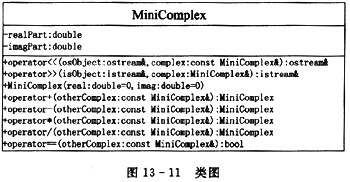
【代码13-l】
/*___________________________________*/
/********* 文件 MiniComplex. h*********/
/*___________________________________*/
include<iostream>
using namespace std;
class MiniComplex
{(1):
//重载流插入和提取运算符
(2) ostream & operator <<(ostream & osObject, const MiniComplex & complex)
{ osObject <<"("<<complex. realPart<<"+"<<complex. imagPart <<"I"<<")";
return osObject;
}
friend (3) operator >>(istream & isObject, MiniComplex & complex)
{ char ch;
isObject >>complex. realPart >>ch>>complex. imagPart >>ch;
return isObject;
}
MiniComplex(double real=0, double imag=0); //构造函数
MiniComplex operator+(const MiniComplex & otherComplex)const! //重载运算符+
MiniComplex operator--(const MiniComplex & otherComplex)const! //重载运算符-
MiniComplex operator*(const MiniComplex& othmComplex)const; //重载运算符*
MiniComplex operator/(const MiniComplex & otherComplex)const; //重载运算符/
bool perator==(const MiniComplex &otherComplex)const; //重载运算符==
private:
double realPart; //存储实部变量
double imagPart; //存储虚部变量
};
/*_______________________________________________________*/
/* * * * * * * * *文件 MiniComplex. cpp* * * * * * * * * */
/*_______________________________________________________*/
include "MiniComplex.h"
bool MiniComplex:: perator==(const MiniComplex & otherComplex)const
{ (1);}
MiniComplex:: MiniComplex(double real, double imag){realPart=real;imagPart=imag!}
MiniComplex MiniComplex:: operator+(const MiniComplex & otherComplex)const
{ MiniComplex temp;
temp. realPart=realPart+ otherComplex. realPart;
temp. imagPart=imagPart+ otherComplex. imagPart;
return temp;
}
MiniComplex MiniComplex::operator--(const MiniComplex & otherComplex)const
{ MiniComplex temp;
temp.realPart=realPart-otherComplex.realPart;
temp. imagPart=imagPart-otherCompler.imagPart;
return temp;
}
MiniComplex MiniComplex:: operator*(const MiniComplex& otherComplex)const
{ MiniComplex temp;
temp.realPart=(realPart* otherComplex.realPart)-(imag-Part* otherComplex.imag-Part);
temp imagPart=(realPart* otherComplex. imagPart)+(imag-Part *otherComplex.realPart);
return temp,
}
MiniComplex MiniComplex:: operator/(const MiniComplex& otherComplex)eonst
{ MiniComplex temp;
float tt;
tt=1/(otherComplex. realPart *otherComplex. realPart+otherComplex. imagPart* other Complex.imagPart);
temp. realPart=((realPart* otherComplex.realPart)+(imagPart* otherComplex.imagPart))*tt;
temp. imagPart=((imagPart * otherComplex.realPart)-(realPart* otherComplex.imagPart))*tt;<
相似考题
更多“ 阅读以下说明和C++代码(代码13-1),将应填入(n)处的字句写在对应栏内。【说明】软件设计师东方飞龙利用UML设计了一个迷你小型复数类,其类图如图13-11所示。【代码13-l】/*_____________”相关问题
-
第1题:
阅读下列说明和C++代码,回答问题,将解答填入答题纸的对应栏内。
【说明】某航空公司的会员积分系统将其会员划分为:普卡 (Basic)、银卡(Silver)和金卡 (Gold) 三个等级。非会员 (NonMember) 可以申请成为普卡会员。会员的等级根据其一年内累积 的里程数进行调整。描述会员等级调整的状态图如图 5-1 所示。现采用状态 (State) 模式实现上述场景,得到如图 5-2 所示的类图。

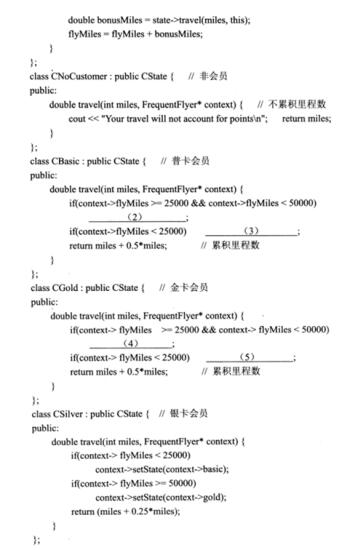
【问题1】(15分)阅读上述说明和C++代码,将应填入 (n) 处的字句写在答题纸的对应栏内。答案:解析:注意:原版的题目应该是Cbasic、CSilve。(1) virtual double travel(int miles,FrequentFlyer* context)=0(2)context->setState(context->Cbasic)(3)context->setState(context->CSilve)(4)context->setState(context->Cbasic)(5)context->setState(context->CSilve) -
第2题:
阅读下列说明和Java代码,将应填入(n)处的字句写在答题纸的对应栏内。【说明】 某文件管理系统中定义了类OfficeDoc和DocExplorer,当类OfficeDoc发生变化时,类DocExplorer的所有对象都要更新其自身的状态,现采用观察者(Observer)设计模式来实现该需求,所设计的类图如图6-1所示。
 答案:解析:1: void update()2: Observer3: obs.update()4: Subject5: Attach(this)
答案:解析:1: void update()2: Observer3: obs.update()4: Subject5: Attach(this) -
第3题:
阅读下列说明和?C++代码,将应填入(n)处的字句写在答题纸的对应栏内。
【说明】
阅读下列说明和?Java代码,将应填入?(n)?处的字句写在答题纸的对应栏内。
【说明】
某快餐厅主要制作并出售儿童套餐,一般包括主餐(各类比萨)、饮料和玩具,其餐品种
类可能不同,但其制作过程相同。前台服务员?(Waiter)?调度厨师制作套餐。现采用生成器?(Builder)?模式实现制作过程,得到如图?6-1?所示的类图。
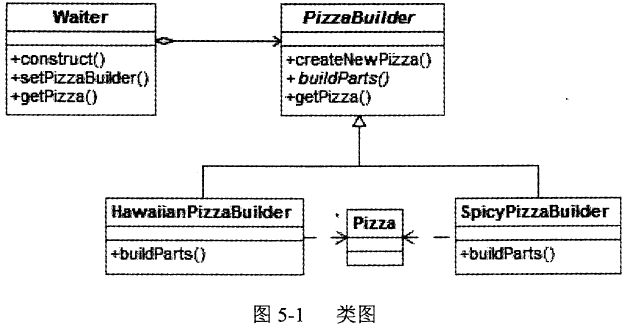
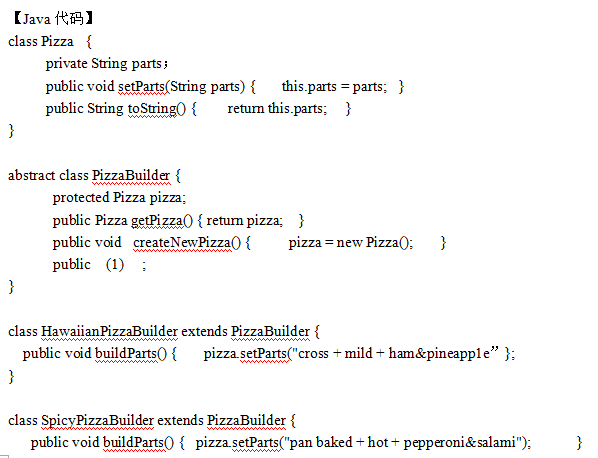
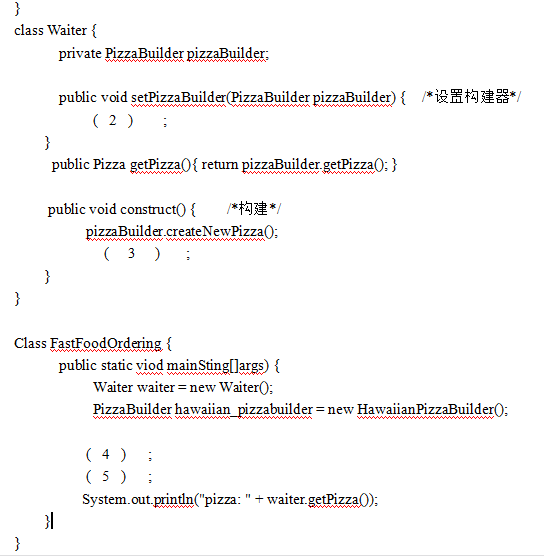
 答案:解析:
答案:解析:
-
第4题:
阅读下列说明和 Java 代码,将应填入(n)处的字句写在答题纸的对应栏内。 【说明】 某软件公司欲开发一款汽车竞速类游戏,需要模拟长轮胎和短轮胎急刹车时在路面上 留 下的不同痕迹,并考虑后续能模拟更多种轮胎急刹车时的痕迹。现采用策略(Strategy) 设 计模式来实现该需求,所设计的类图如图 5-1 所示。

 答案:解析:1.void stop()2.BrakeBehavior3.wheel.stop()4.wheel=behavior5.brake()
答案:解析:1.void stop()2.BrakeBehavior3.wheel.stop()4.wheel=behavior5.brake() -
第5题:
阅读下列说明和 Java 代码,将应填入(n)处的字句写在答题纸的对应栏内。
【说明】
生成器( Builder)模式的意图是将一个复杂对象的构建与它的表示分离,使得同样的构建过程可以创建不同的表示。图 6-1 所示为其类图。
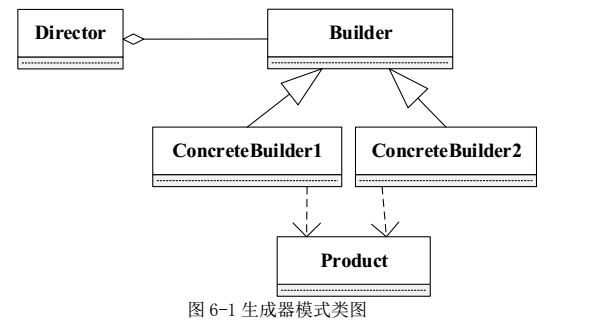
阅读下列说明和C++代码,将应填入(n)处的字句写在答题纸的对应栏内。
【说明】
???? 生成器(Builder)模式的意图是将一个复杂对象的构建与它的表示分离,使得同样的构建过程可以创建不同的表示。图5-1所示为其类图。
?
【C++代码】
#include
#include
using namespace std;
class Product {
private:?
string partA, partB;
public:?
Product() {?? }? ?
void setPartA(const string& s) { PartA = s;}
???? void setPartB(const string& s) { PartB
= s;}? ?
//? 其余代码省略
};
class Builder {
public:? ? ??
(1)??
;?
virtual void buildPartB()=0;? ? ?
(2)??
;
};
class ConcreteBuilder1 : public Builder {
private:?
Product*?? product;
public:
ConcreteBuilder1() {product = new Product();???? }
void buildPartA() {????? (3)???? ("Component
A"); }?
void buildPartB() {????? (4)???? ("Component
B"); }??
Product* getResult() { return product; }
//? 其余代码省略
};
class ConcreteBuilder2 : public Builder {? ??? ? ? ?
/*??? 代码省略??? */
};
class Director {
private:? ??
Builder* builder;
public:??
Director(Builder* pBuilder) { builder= pBuilder;}? ??
void construct() {
????????????????? (5)???? ;
?????????????? //? 其余代码省略? ?
}??
//? 其余代码省略
};
int main() {? ? ??
Director* director1 = new Director(new ConcreteBuilder1());? ?
director1->construct();? ? ??
delete director1;? ? ?
return 0;
【Java代码】
import jav(6)A.util.*;
class Product {? ? ? ?
private String partA;? ? ? ?
private String partB;? ? ? ??
public Product() {}? ? ??
public void setPartA(String s) { partA = s; }? ? ? ?
public void setPartB(String s) { partB = s; }
}
interface Builder {? ?
public?????? (1)???? ;? ??
public void buildPartB();? ? ??
public?????? (2)???? ;
}
class ConcreteBuilder1 implements Builder {? ? ? ?
private Product product;? ? ? ?
public ConcreteBuilder1() { product = new Product();?? }? ? ? ??
public void buildPartA() {????????
(3)??
("Component A"); }
public void buildPartB() {???? ????(4)?? ("Component B"); }? ? ??
public Product getResult() { return product;}
}
class ConcreteBuilder2 implements Builder {?? ? ? ? ?
//? 代码省略
}
class Director {? ? ? ?
private Builder builder;? ? ? ?
public Director(Builder builder) {this.builder = builder; }
public void construct() {
? ? ? ? ? ? ? ? ? (5)???? ;
? ? ? ? ? ? ? //? 代码省略? ? ??
}
}
class Test {? ? ??
public static void main(String[] args) {
???????????????? Director director1 = new
Director(new ConcreteBuilder1());
???????????????? director1.construct();? ? ? ??
}答案:解析:(1)void buildPart A()
(2) Product getResult()
(3)product.setPartA
(4)product.setPartB
(5)builder.buildPartA();
builder.buildPartB();
Product p=builder.getResult();
